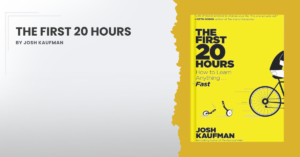Title: The Tipping Point: How Little Things Can Make a Big Difference
Author: Malcolm Gladwell
Year: 2006
Pages: 288
The Tipping Point is a fascinating book that offers insights into how ideas and social trends spread. It is a must-read for anyone who is interested in understanding how the world works.
The tipping point is that magic moment when an idea, trend, or social behaviour crosses a threshold, tips, and spreads like wildfire.Just as a single sick person can start an epidemic of the flu, so too can a small but precisely targeted push cause a fashion trend, the popularity of a new product, or a drop in the crime rate.
This widely acclaimed bestseller, in which Malcolm Gladwell explores and brilliantly illuminates the tipping point phenomenon, is already changing the way people throughout the world think about selling products and disseminating ideas.
As a result, I gave this book a rating of 8.5/10.
For me, a book with a note 10 is one I consider reading again every year. Among the books I rank with 10, for example, is Dale Carnegie’s How to Win Friends and Influence People.
3 Reasons to read The Tipping Point
1. The law of the few: A few people play a disproportionate role in spreading ideas. The experts who know a lot about a particular topic and often the first to adopt new ideas and products. The connectors who know a lot of people and spread ideas from one social circle to another. And the salesmen are people who are skilled at persuading others to adopt new ideas.
2. The stickiness factor: An idea is more likely to spread if it is “sticky.” This means that it is easy to remember, understand, and communicate. Sticky ideas typically have simple messages that resonate with people’s emotions.
3. The power of context: The way in which an idea is introduced can also affect its chances of spreading. For example, an idea is more likely to spread if it is introduced at a time when people are already receptive to it.
Book Overview
Whether you’re a marketer aiming to spark a viral campaign, a sociologist seeking to comprehend collective behaviour, or simply a curious mind intrigued by human psychology, The Tipping Point has something profound to offer.
Through its pages, we will come to understand how seemingly insignificant changes can lead to extraordinary effects, how a few key individuals can act as powerful influencers, and how the context shapes the emergence of a social epidemic.
By delving into a diverse range of real-life examples and historical events, The Tipping Point weaves a narrative that unveils the essential principles governing these transformative tipping points.
The main idea of The Tipping Point by Malcolm Gladwell is to explore and explain the concept of social epidemics and tipping points.
The Tipping Point investigates how small changes, events, or actions can lead to significant and sudden shifts in society, causing ideas, behaviours, or trends to spread rapidly and become widespread phenomena.
The Tipping Point identifies three crucial factors that contribute to the tipping of a social epidemic: the “Law of the Few” (the influence of key individuals), the “Stickiness Factor” (the ability of an idea to remain in people’s minds), and the “Power of Context” (the impact of the environment and circumstances).
What are the Key Ideas
Tipping Point: The central concept of the book is the tipping point itself, which refers to the moment when a small change or action leads to a significant and rapid transformation in a social system. It is the critical point where an idea, behavior, or trend crosses a threshold and spreads like wildfire, becoming a widespread phenomenon.
The Law of the Few: The Tipping Point introduces the idea that a select group of individuals, known as “Connectors,” “Mavens,” and “Salesmen,” play a disproportionately influential role in driving social epidemics. Connectors have vast social networks and connect people across different circles, Mavens possess deep knowledge and expertise and share it willingly, and Salesmen are persuasive and charismatic communicators.
The Stickiness Factor: This concept refers to the ability of an idea, message, or product to remain memorable and resonate with the audience. Ideas with a high Stickiness Factor stick in people’s minds and are more likely to be shared and spread, contributing to a tipping point.
The Power of Context: The Tipping Point emphasizes the significant impact of the environment and circumstances in shaping human behavior. Small changes in the context or conditions can have a disproportionate influence on the success or failure of an idea or trend, contributing to its tipping point.
Epidemics as Social Contagions: The Tipping Point views social epidemics as akin to infectious diseases, spreading through social networks and social interactions. Gladwell draws parallels between the spread of ideas and the spread of contagious illnesses, highlighting the role of influencers and the context in fueling or curbing their diffusion.
Unpredictability of Tipping Points: Gladwell argues that tipping points are not always predictable or linear. Small changes can accumulate over time until a tipping point is reached, and the outcome may seem sudden and unexpected.
Practical Applications: Throughout the book, Gladwell provides real-life examples of how these concepts operate in various contexts, such as the rise of Hush Puppies shoe brand, the decrease in New York City crime rate, and the popularity of children’s TV shows like Sesame Street. He also offers insights for businesses, marketers, and policymakers on how to create and harness tipping points for positive change.
What are the Main Lessons
Focus on Influencers: For digital creators, understanding the power of influencers is crucial. Identify key connectors, mavens, and salesmen in your niche or industry who can help amplify your message or content. Building relationships with these influential individuals can significantly increase your reach and impact.
Create Sticky Content: In the digital realm, content is king. Ensure that your content is compelling, memorable, and easily shareable. Aim to create content with a high Stickiness Factor, so it stays in the minds of your audience and encourages them to share it with others.
Utilize Social Networks: Take advantage of social networks to disseminate your work. Engage with your audience and encourage them to share your content with their networks. Social media platforms can be powerful tools to facilitate the tipping process and lead to exponential growth.
Understand the Power of Context: The context in which your content is presented can significantly impact its reception. Pay attention to the timing, environment, and circumstances surrounding your work. A small change in context can make a significant difference in how your content is perceived and shared.
Embrace Unpredictability: Tipping points are not always easy to predict. Be open to experimentation and ready to adapt your strategies based on feedback and data. Stay agile and responsive to changes in the digital landscape.
Aim for Virality: Digital creators should strive for their content to go viral, but it’s essential to understand that virality often arises from a combination of factors, including content quality, timing, and influential sharing. While you can’t guarantee virality, you can optimize your chances by focusing on the factors that contribute to tipping points.
Build Long-term Relationships: Cultivate a loyal audience and build long-term relationships with your followers or customers. Repeat engagement and word-of-mouth recommendations from satisfied customers can contribute to sustained success and gradual tipping points.
Measure and Analyze: Monitor and analyze the performance of your content and strategies. Use data-driven insights to refine your approach and make informed decisions about content creation and distribution.
Be Mindful of Negative Tipping Points: Just as positive tipping points can lead to explosive growth, negative tipping points can also occur, leading to reputational damage or backlash. Be mindful of potential negative consequences and address any issues proactively.
My Book Highlights & Quotes
There is a simple way to package information that, under the right circumstances, can make it irresistible. All you have to do is find it
The idea that epidemics can rise or fall in one dramatic moment — is the most important, because it is the principle that… permits the greatest insight into why modern change happens the way it does
When it comes to epidemics, though, this disproportionality becomes even more extreme; a tiny percentage of people do the majority of the work
To create one contagious movement, you often have to create many small movements first
The tipping point is that magic moment when an idea, trend, or social behavior crosses a threshold, tips, and spreads like wildfire
To be someone’s best friend requires a minimum investment of time. More than that, though, it takes emotional energy. Caring about someone deeply is exhausting
Emotion is contagious
If you want to bring a fundamental change in people’s belief and behavior…you need to create a community around them, where those new beliefs can be practiced and expressed and nurtured
There are exceptional people out there who are capable of starting epidemics. All you have to do is find them
A study at the University of Utah found that if you ask someone why he is friendly with someone else, he’ll say it is because he and his friend share similar attitudes. But if you actually quiz the two of them on their attitudes, you’ll find out that what they actually share is similar activities. We’re friends with the people we do things with, as much as we are with the people we resemble. We don’t seek out friends, in other words. We associate with the people who occupy the same small, physical spaces that we do
By analysing numerous case studies and historical events, Gladwell sheds light on the hidden dynamics behind these tipping points, offering valuable insights into how social change occurs and how influential agents can drive such transformations.
In the digital landscape, understanding the dynamics of tipping points and employing the principles explored in The Tipping Point can help digital creators achieve wider recognition, increase their impact, and navigate the ever-changing landscape of online content and careers.
I am incredibly grateful that you have taken the time to read this post.
Do you want to explore more?
Check my main categories of content below:
- Agile
- Blog
- Book Notes
- Career
- Leadership
- Management
- Managing Yourself
- Productivity
- Project Management
- Technology
- Weekly Pulse
Navigate between the many topics covered in this website:
Agile Art Artificial Intelligence Blockchain Books Business Business Tales Career Coaching Communication Creativity Culture Cybersecurity Design DevOps Economy Emotional Intelligence Feedback Flow Focus Gaming Goals GPT Habits Health History Innovation Kanban Leadership Lean Life Managament Management Mentorship Metaverse Metrics Mindset Minimalism Motivation Negotiation Networking Neuroscience NFT Ownership Parenting Planning PMBOK PMI Politics Productivity Products Project Management Projects Pulse Readings Routines Scrum Self-Improvement Self-Management Sleep Startups Strategy Team Building Technology Time Management Volunteering Work
Do you want to check previous Book Notes? Check these from the last couple of weeks:
- Book Notes #124: Radical Candor by Kim Scott
- Book Notes #123: The Personal MBA by Josh Kaufman
- Book Notes #122: The First 20 Hours by Josh Kaufman
- Book Notes #121: A World Without Email by Cal Newport
- Book Notes #120: Storynomics by Robert McKee and Thomas Gerace
Support my work by sharing my content with your network using the sharing buttons below.
Want to show your support tangibly? A virtual coffee is a small but nice way to show your appreciation and give me the extra energy to keep crafting valuable content! Pay me a coffee:




